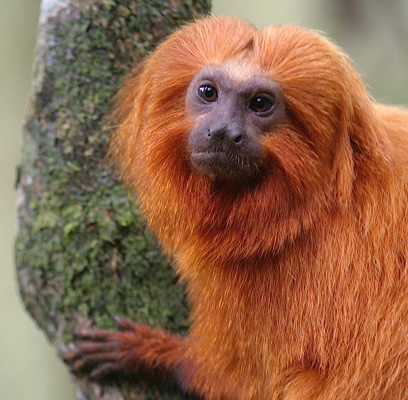Habitat
Callithrix pygmaea
has been found to live in evergreen forests throughout the western
Amazon basin in South America. Pygmy Marmosets are also present in
parts of Ecuador, Peru, and Bolivia along the Japura River, Ucayali
River, Purus River, and Solimoes River (Townsend, 2001). The Amazon
rainforest is one of the most popular rainforests and gets its name
from the vital Amazon River that winds through the forests at a
length of 4,080 miles. One of the largest river systems in the
world, the Amazon River can reach a width of 35 miles at some
points, (Blue Plant Biomes, 2003). The Amazon’s average temperature
remains around 88 degrees Fahrenheit and has a large role in keeping
the Amazon cozy for the pygmy marmoset. The Amazon rainforest also
has an average of 100 inches of rain each year amounting to about
250 days out of the year that experience rainfall. One of the most
marveling things about the Amazon rainforest is its sheer size. The
Amazon rainforest covers about 2.5 million square miles of the earth
and generates 20% of the world’s oxygen, (ACEER, 1991).
Specifically Pygmy
Marmosets
Pygmy marmosets prefer to
live within the trees avoiding the floor of the forest along with
heights greater than 18 to 20 meters above ground (Lang 2005; Wade
2012). Their distribution across the forest is directly related to
the abundance of trees they use as their food source including, but
not limited to Chupa Chupa trees,and Hog Plum trees
(Townsend, 2001). Callithrix pygmaea are extremely
specific with the type of environment they will occupy in that they
prefer river flood plains with two to three meters of standing water or river-edge forests, (Lang, 2005).
Pygmy marmosets are not alone in the forest either. Some big cat predators in the Amazon are the cougar and jaguar. Some friendlier faces are the golden lion tamarin, scarlet macaw, two-toed sloth, and pit viper. The golden lion tamarin are similar to the pygmy marmosets in that they reside in the trees of the Amazon forest and enjoy the river-edge or swamp forests found through the rainy months from October to April, ( Lang, 2010). The two-toed sloth can be found in the same vicinity as the pygmy marmoset because they can often be found lounging in the tropical rainforest canopies, (Smithsonian, 2013). However, the scarlet macaw is unlike the pygmy marmosets in that they can fly! The scarlet Macaw can be seen resting above the pygmy marmoset in the tropical canopies of the Amazon basin, (Mijal, 2001).

